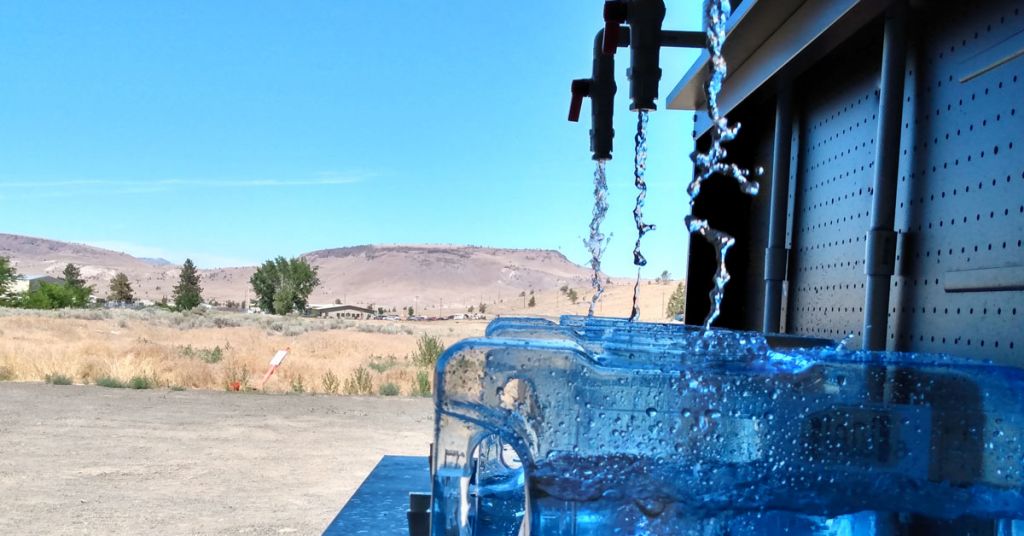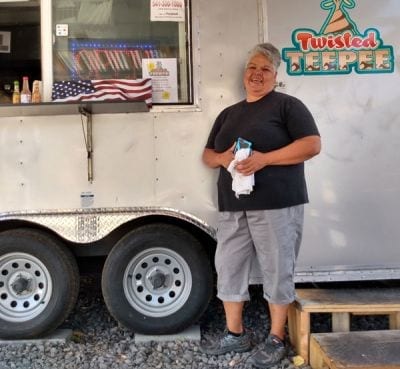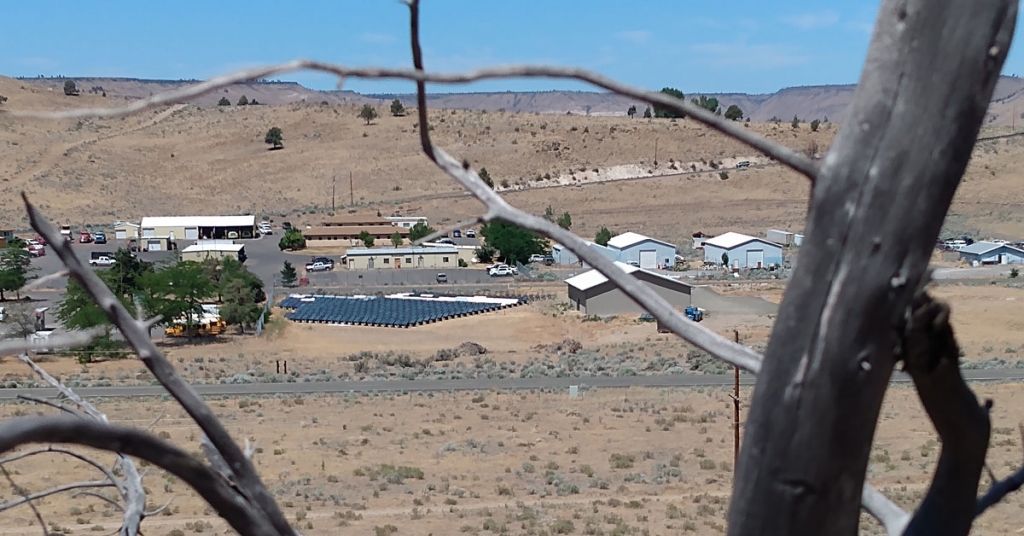New hydropanel technology extracts moisture from the atmosphere, helping alleviate water crisis on the reservation

Drops in the bucket: Clean, mineralized drinking water fills reusable jugs at a filling station where tribal citizens can pick up as much as they need. Photo by B. “Toastie” Oaster
By B. “Toastie” Oaster, July 22, 2021. Walking from the Twisted Teepee frybread cart past the offices of the Warm Springs Community Action Team, you’ll notice a strange hum. At the end of the cul-de-sac, overlooking the sagebrush bluffs of the 1,000-square-mile Warm Springs reservation, stand 10 black panels, tilted toward the sun’s southern arc.
They’re easy to mistake for solar panels, except for the drone of their internal fans. They’re called hydropanels, and they’re creating drinking water out of air.
The Warm Springs water crisis is in its fifth year, with periodic boil notices leaving some families struggling to access clean drinking water. Roughly 3,300 people live on the reservation. While state and federal governments have helped, a comprehensive solution has remained elusive.
But Warm Springs has found an innovative partial fix, with the help of private donors. These donors fronted the money for 200 hydropanels, at $2,000 each.
VIDEO: Under pressure: The Oregon community desperate for water
Once installed, the panels began producing 160 gallons of mineralized drinking water every day, according to Jim Souers, CEO of the Warm Springs Economic Development Corporation.
“The purpose behind it is to create free water for the community,” says Souers. “That was it. That was the priority, that was the mission: free water for the community.”
The tribe decided to match the donation, and more. It opened a one-acre field for the array, which is now at 250 panels, with brackets standing ready for an incoming 50 more. Souers says the vision is to keep expanding capacity.
“The tribe stepped up to expand the field to the complete acre,” he explains. “So that’s going to get to 720 gallons a day.”
Residents take what they need
Each panel is fitted with fans similar to the ones cooling your computer processor. These fans draw in air from the surrounding atmosphere and force it through a hygroscopic material that absorbs the air’s moisture. The moisture then drips into an internal reservoir, where it’s mineralized and pumped through a circulator that keeps it fresh for up to a year.

Hip hip array: Hydropanels have lasted through winter freezes. B. “Toastie” Oaster
Solar power keeps the internal electronics working, and solar thermal drives the water extraction.
The water then pipes to a small adjacent warehouse with a filling station, where contractors bottle it into reusable 2.5-gallon jugs, just the right size to fit in a household fridge. On Mondays, the warehouse doors open and anyone from the community can come by and help themselves.
“It’s unmanned. We open it and leave it,” says Souers. “Doesn’t stop anybody from bringing their own five-gallon commercial bottle or other container they want to put water in, much like they would if they went to one of our natural springs.”
Source Global, the company that makes the panels, is training Warm Springs contractors as technicians to maintain the array. The company says most of the installation was done by tribal members.
Work crews have given away several thousand bottles to residents already, and the community response has been positive. In addition to the main array, 36 remote households have been outfitted so far with pairs of panels for the families who live there. And there are the 10 panels near the Twisted Teepee frybread cart, a demo run rolled out last autumn.
Cooking frybread with hydropanel water
Starla Green manages the Twisted Teepee, where she trains community members on food service and small-business management, while serving up fluffy, hot frybread with huckleberry butter.

Warm welcome: Starla Green manages Twisted Teepee, a grant-funded initiative of the Warm Springs Community Action Team. B. “Toastie” Oaster
“I use the water when I’m cooking inside, in all the beverages I serve,” she says. “It was a lifesaver, especially when we went into a boil-water notice.”
When pipe disruptions made drinking water unsafe, Green had to either boil water first, or buy it and haul in bottles.
Some of the nearby hydropanels run water to a tap on the side of the food cart. The tap is also a public resource. People come by regularly to fill up.
Green says sometimes if people bring big jugs, they max out the panels’ capacity.
“Guess we’ve got to wait a day,” she says with a smile. “It slowly refills itself.”
She says the panels quiet down at night when there’s no sunlight.
“It’s really cool, in the wintertime when the temperatures drop to below freezing levels, it automatically shuts off,” she adds.
MORE: Environmental justice at Hanford: Reconnecting Indigenous people with their land
Although she has well water at home, Green says she prefers the taste of the hydropanel’s water.
“I wish I could get it at my house, because the taste is that clean and crisp,” she says.
Panels are data connected
“Each one of the hydropanels we deploy around the world is connected to our network operations center in Scottsdale, Arizona. It’s monitored in real time,” says Colin Goddard, senior director at Source Global. A modem affixed to each panel transmits information about performance. “We allow end users to access the digestible portion of the data in an app on their individual system.”
To access the app, users need an iPhone or other iOS device. Goddard says they’re working on an Android version.
“Our objective is to become the cheapest source of high-quality drinking water on the planet,” he says. “The cheapest and the quickest to deploy.”

Drink it in: Amid buildings on the Warm Springs reservation, an array of hydropanels create water from sunlight and air. B. “Toastie” Oaster
While initial installation costs are high, low operational costs temper the price tag over the long term.
“There’s very little overhead,” says Souers. “We have minimal, if anything, operation costs. That allowed my group to take ownership of it and say ‘we can do this.’”
He notes that a traditional method, such as trucking in water, incurs overhead like fuel, paying a driver and engine maintenance. That’s not even accounting for environmental factors.
“The company stepped up and said ‘well, you can have a 10-year warranty, free parts and labor.’ That’s like unheard of,” says Souers, crediting it as a commitment to the community. “So it was a pretty obvious decision.”
The panels are designed to last 15 years before they need any serious servicing.
‘Cost competitive’ with bottled water
“We are currently cost competitive with single-use plastic bottled water, on a per liter basis, if you amortize those costs over the 15-year life,” says Goddard.
A 24-pack of 16.9 ounce Nestle water bottles runs on Amazon for $12.25, or $3.92 per gallon. At Walmart, a gallon of purified drinking water is 80 cents. So even at $2,000 per panel, 200 panels producing 160 gallons a year comes out 46 cents per gallon over the 15-year lifetime of the panels, significantly cheaper than retail bottles. And without the environmental burden of single-use plastics.
Goddard says the panels were designed for remote communities. Source Global has also installed panels in the Navajo Nation, the Buttah Windee community in Western Australia and a Saudi Arabian resort, among other locations.
Subscribe to Columbia Insight. It’s free.
Souers says providing water is fundamental, as well as culturally significant.
“The tribe and the culture here, and most Indigenous communities realize, it’s the blood of the earth,” he says. “And for an outside group to recognize how important it is, and to make a substantial commitment to this community, it’s really humbling to know that there’s people out there that are going to make a significant difference.”
“We’re so thankful,” he says. “It only happened because other people care.”
READ MORE INDIGENOUS ISSUES STORIES.

The Collins Foundation is a supporter of Columbia Insight’s Indigenous Issues series.






